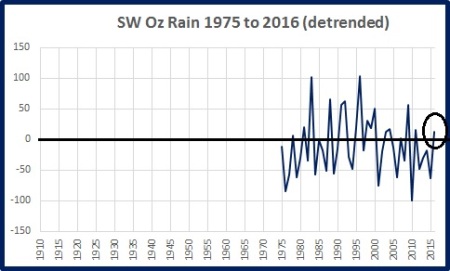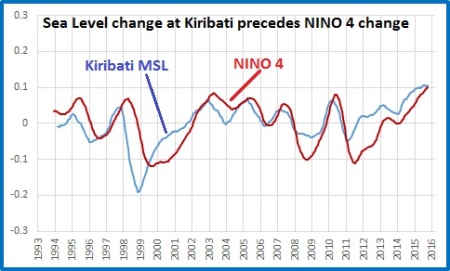Satellite data from UAH (University of Alabama- Huntsville) are estimates of temperature in the Lower Troposphere, and thus a good indicator of whether greenhouse warming is occurring. My next post about the length of The Pause in various regions will be ready in a few days’ time. Meanwhile, I’ve been looking at the data in a different way.
In this post I will be examining how and when temperatures have changed in discrete regions of the globe, including over land and over oceans. There are no startling revelations, but a different approach reinforces the need to understand climate variability in different regions. The important regions of course are the Tropics and the Poles, and fortunately UAH data is available separately for just these three regions.
Firstly, Figure 1 shows the regions for which UAH has atmospheric data.
Fig. 1: UAH Data Regions

The Northern and Southern Extra-Tropics include the Polar regions, so there are three discrete regions which do not overlap: Tropics, North Polar, and South Polar. It would be very helpful if Dr Spencer provided data for the Extra Tropical regions excluding the Polar Regions.
For this analysis I use CuSum, which is a simple test of data useful for detecting linearity or otherwise, and identifying sudden changes in trend, or step changes. It can be used for any data at all- bank balance, car accidents, rainfall, GDP, or temperature. It is simple to use: find the mean of the entire data, calculate differences for every data point from this mean, then calculate the running sum (Cumulative Sum) of the differences. If done correctly, the final figure will be zero. Plot the CuSum usually by time and identify points of any sudden change in direction. A generally straight or smoothly curving line indicates linearity, but points of sudden change mean a change in trend or a step change. (Further, data series with identical start and end points, exactly the same number of data points, and anomalies from the same period- such as UAH- should produce directly comparable CuSums.) These points, and ranges between them, are then checked in the original data. The usefulness of CuSums will become obvious as we go, especially as they are compared.
The next figures show CuSum plots for various regions.
Fig. 2: UAH CuSums for all regions

Points to note:
The brown line at the top is the South Polar region. The line wobbles about zero, indicating little relative change in temperature from the mean. Contrast this with the North Polar region (the blue line at the bottom.) The Polar regions are conspicuously different from the other regions and from each other.
The spaghetti lines clustered in the middle are CuSums for (in order from top to bottom): Southern Extra-Tropics; Southern Hemisphere; Tropics; Globe; Northern Hemisphere; Northern Extra-Tropics.
The red arrows point to wobbles coinciding with major ENSO events. These changes in direction indicate trend changes or step changes in the original data. There are other changepoints, notably 2002-2003.
The vertical red line joins changepoints in all the CuSums in mid-1991 following the eruption of Mt Pinatubo.
Fig. 3: UAH CuSums for the Tropics, South Polar, and North Polar regions

Note there is little similarity between CuSums for the only regions with discrete data, and you have to look carefully to see North Polar CuSums changing some months after Tropics, but not always.
The next plots show the differing responses of Land and Ocean areas.
Fig. 4: UAH CuSums for the Globe, Land and Ocean

Note that Land areas have greater relative temperature changes than the Oceans, and that the Global mean closely mirrors the Ocean CuSums (as the Globe is mostly Ocean). The major turning point is in 1997-98.
Fig. 5: UAH CuSums for the Tropics, Land and Ocean

Note once again the mean CuSums closely follow that of the Ocean as 20 degrees North to 20 degrees South is mostly water. The changepoints are very distinct.
Fig. 6: UAH CuSums for the North Polar region, Land and Ocean

Note that all CuSums are close, but after 1982 Ocean CuSum changes relatively more than Land- the blue line has switched to below the mean. The main changepoints are 1991, 1993-94, 2002, 2009, and 2015.
Fig. 7: UAH CuSums for the South Polar region, Land and Ocean

Now that is interesting. Note all three CuSums have similar changepoints, but Land varies more than Ocean and after 1992 Land is largely negative, Ocean is largely positive. The Land CuSum range is about half of the North Polar equivalent.
Remember CuSums in Figure 4 showed Land temperatures must vary more than Ocean (though not in the North Polar region). The next figures show plots of UAH original data (not CuSums).
Fig. 8: UAH original data for the Globe, Land and Ocean

I find a visual representation demonstrates greater relative variation in Land temperatures well.
Fig. 9: UAH original data for the Tropics, Land and Ocean

Note much greater fluctuation with ENSO, and Land varying a little more that Ocean.
Fig. 10: UAH original data for the North Polar region, Land and Ocean

Note the much greater variation, but Land is more often than not masked by Ocean.
Fig. 11: UAH original data for the South Polar region, Land and Ocean

Note the much greater range in Land data, with large non-linear multi-year swings- calculate a linear trend for Land at your peril.
Having found changepoints, we can now analyse periods between them. One way is to calculate means, and step changes between periods.
Fig. 12: UAH original data for the Tropics based on CuSum changepoints

I deliberately ignored the 2001 changepoint- it made very little difference to means and appears to be a continuation of the series starting in 1997. Note the step changes are very small, and the final step change is reliant on current data and will change. While I have shown means and steps, the data are decidedly non-linear with sharp spikes and multi-year rises and falls.
Fig. 13: UAH original data for the North Polar region based on CuSum changepoints

Note the large step change in the mid-1990s occurs before the 1997-98 El Nino. The range is much greater than the Tropics.
As the Land data for the South Polar region looks more interesting, I decided to use Land instead of the mean.
Fig. 14: UAH original data for the South Polar region (Land data) based on CuSum changepoints

Up and down like a toilet seat!
Conclusions:
The data series are characterised by step changes and multi-year rises and falls.
The Polar regions are “poles apart” in their climate behaviours. Explanations might include: different geography (an ocean almost surrounded by land but subject to warming and cooling currents vs a continent isolated from the rest of the world by a vast ocean); different snow and ice albedo responses; different cloud influences.
The Global mean combines data from regions with very different climatic behaviour. Averaging hides what is really going on. The Tropics are governed by ENSO events, and the Poles are completely different.
Please Dr Spencer can you provide separate data for 20-60 degrees North and South?
Comments and interpretations are most welcome.























































